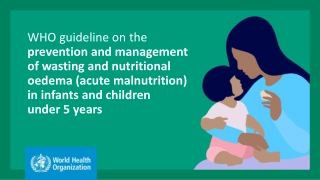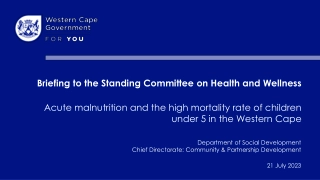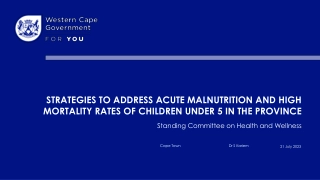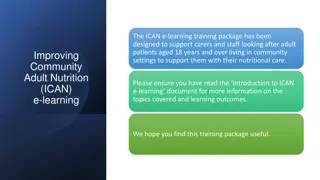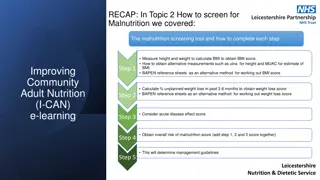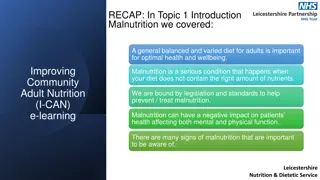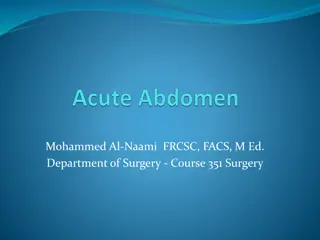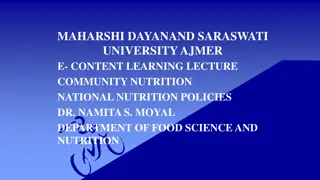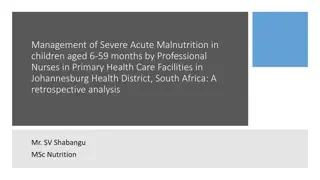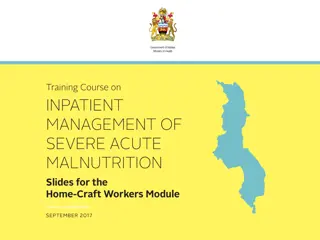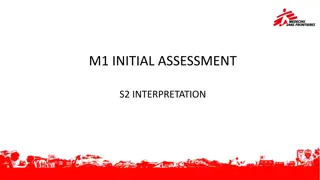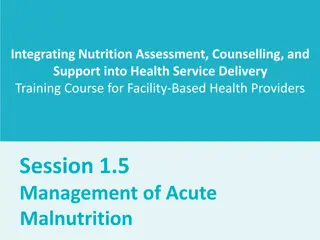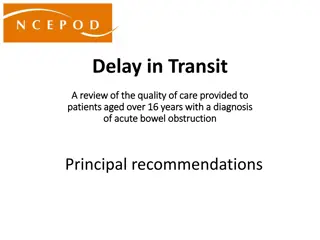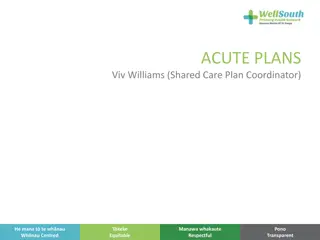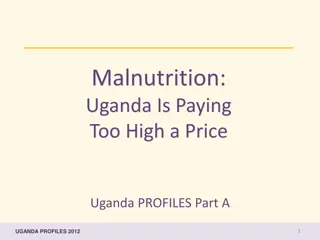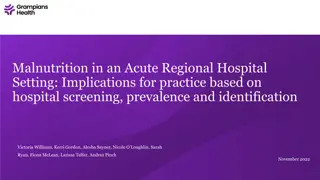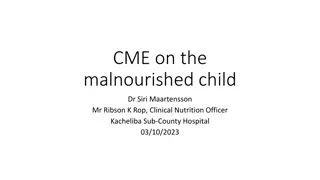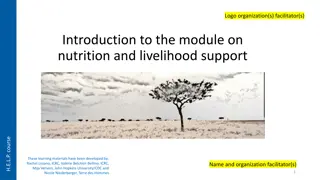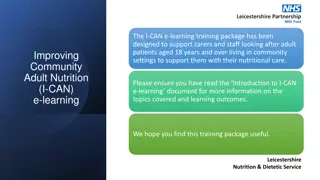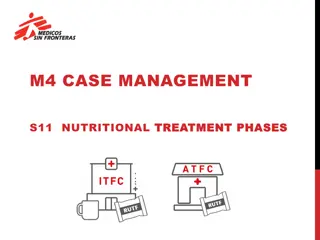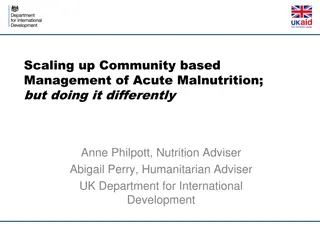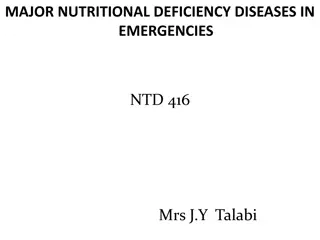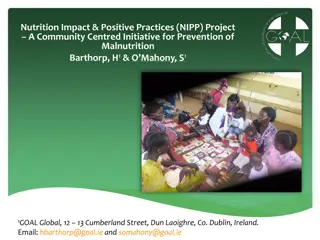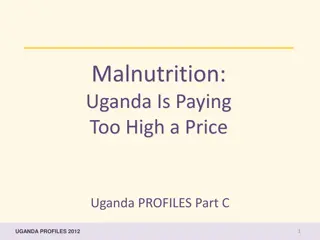WHO Guideline: Prevention & Management of Malnutrition in Infants & Children
Key insights from WHO's guideline on managing wasting and malnutrition in children under 5. Covers assessment, care for infants and mothers, and treatment strategies for different malnutrition levels
3 views • 37 slides
Addressing Acute Malnutrition and High Child Mortality in Western Cape: Community Development Strategies
Update on the strategies implemented by the Chief Directorate to combat acute malnutrition and high mortality rates among children under 5 in the Western Cape. The Sustainable Livelihoods Programme focuses on social inclusion and poverty alleviation through targeted feeding and access to government
8 views • 14 slides
Strategies for Managing Malnutrition with Nutritional Care Plans
Understanding how to create and implement a nutritional care plan based on the MUST score, including strategies like Food First and Fortification, can help manage malnutrition effectively. This involves utilizing nutrient-dense foods, promoting wound healing, increasing muscle strength, and improvin
0 views • 18 slides
Treatment of Acute malnutrition using Simplified Approaches.
Simplified approaches in the treatment of acute malnutrition involve modifications to existing protocols to optimize effectiveness, quality, and cost-efficiency. These approaches include family MUAC screening, CHW-led treatment, reduced follow-up visits, expanded admission criteria, single treatment
1 views • 15 slides
Nutritional Care Planning for Malnutrition Screening
Learn how to screen for malnutrition using tools like BMI calculation and weight loss assessment. Understand the steps to create a nutritional care plan based on MUST scores, including setting aims, implementing agreed plans, and monitoring progress. Gain insights into managing malnutrition risks an
1 views • 12 slides
Strategies to Address Acute Malnutrition and High Mortality Rates in Children Under 5
Malnutrition in children under 5, specifically acute malnutrition, is a pressing issue in the Western Cape. This presentation outlines the current strategies, multisector engagement, causes, and impacts of acute malnutrition. It delves into the classifications of malnutrition, including severe and m
1 views • 38 slides
Screening for Malnutrition with MUST Tool
Understanding malnutrition is crucial for maintaining optimal health. Screening with the Malnutrition Universal Screening Tool (MUST) is essential to identify individuals at risk. This tool involves assessing BMI, calculating weight loss scores, and determining overall malnutrition risk. Proper scre
5 views • 25 slides
Supporting Adult Nutrition in Community Settings - ICAN E-Learning Training
The ICAN E-Learning Training Package is designed to assist carers and staff caring for adult patients aged 18 and over in community settings with their nutritional care. The training covers topics such as national standards in nutrition, defining malnutrition, causes and consequences of malnutrition
7 views • 10 slides
Nutrition Emergency Response in Palestine: Addressing Wasting and Malnutrition
The nutrition situation in Gaza, Palestine is dire, with a significant proportion of the population experiencing food insecurity and malnutrition. A flash appeal highlights the urgent need for funding to support nutrition interventions, especially for vulnerable groups such as infants and pregnant w
4 views • 14 slides
Global Nutrition Prevalence Rates in Children and Women
This content highlights the prevalence rates of acute malnutrition, severe acute malnutrition (SAM), moderate acute malnutrition (MAM), childhood stunting, acute malnutrition based on MUAC and edema, and acute malnutrition in pregnant and lactating women. The data is based on various criteria such a
9 views • 37 slides
Understanding Inflammation and Its Characteristics
Inflammation is the response of tissues to harmful agents, categorized as acute or chronic. Acute inflammation is rapid and short-lived, while chronic inflammation is insidious and prolonged. Chemical mediators play a crucial role in both forms, leading to tissue necrosis. The five cardinal signs of
3 views • 27 slides
Understanding Malnutrition Screening and Nutritional Care Planning
In this overview, discover the process of screening for malnutrition, including calculating BMI, assessing weight loss, and determining overall malnutrition risk. Explore how to create a nutritional care plan based on the MUST score and set appropriate nutritional aims for patients.
0 views • 12 slides
Understanding Malnutrition Screening with MUST Tool
Delve into the importance of malnutrition screening with the Malnutrition Universal Screening Tool (MUST). Learn how to calculate BMI, assess weight loss, and determine overall malnutrition risk. Discover the key steps involved in using the MUST tool for effective patient care and management.
1 views • 25 slides
Comprehensive Overview of Acute Abdomen Assessment and Management
This detailed guide covers the definition, general approach, history taking, physical examination, investigations, diagnosis, and management of acute abdomen cases. Learn about common causes, such as acute appendicitis, bowel obstruction, and medical conditions. Real-life scenarios illustrate differ
2 views • 15 slides
Alarming Malnutrition Situation in India: National Nutrition Policy and Strategies
Malnutrition remains a serious issue in India, with high rates of underweight, stunting, and wasting among children. The National Nutrition Policy emphasizes the need for a comprehensive approach to address the complexities of malnutrition. Despite some improvements, malnutrition continues to impact
0 views • 44 slides
Global Nutrition Report 2019: Progress Against Malnutrition Targets
The Global Nutrition Report tracks progress and actions against global nutrition targets, aiming for a world free from malnutrition. Despite efforts, no country is on track to meet targets for adult obesity and anemia in women. The report highlights the coexistence of wasting, stunting, and overweig
0 views • 18 slides
UNICEF Conceptual Framework on the Causes of Malnutrition
The UNICEF conceptual framework on the causes of malnutrition outlines the multidimensional factors contributing to malnutrition, categorized into immediate, underlying, and basic causes. Immediate causes include inadequate dietary intake and diseases, while underlying causes involve issues like ina
2 views • 18 slides
Inpatient Management of Severe Acute Malnutrition Training Course 2011
This training course focuses on inpatient management of severe acute malnutrition, teaching procedures outlined in the national Community-Based Management of Severe Acute Malnutrition Guidelines. The training aims to reduce case fatality rates significantly and is designed for physicians, senior nur
0 views • 9 slides
Acute Malnutrition - Fluid Management and Treatment Overview
Acute malnutrition, particularly severe acute malnutrition (SAM), requires careful fluid management and a structured treatment approach involving stabilization, transition, and rehabilitation phases. This condition results from inadequate dietary intake or acute infections, leading to severe wasting
0 views • 23 slides
Management of Severe Acute Malnutrition in Children: A Retrospective Study in Johannesburg Health District
Severe Acute Malnutrition (SAM) in children aged 6-59 months is a critical public health concern in Johannesburg, South Africa. This study retrospectively analyzes the classification and management of SAM cases by professional nurses in primary health care facilities. The research highlights the imp
0 views • 14 slides
Comprehensive Overview of Community-Based Management of Acute Malnutrition (CMAM)
The presentation outlines the components and continuum of care in CMAM, including screening criteria for moderate and severe acute malnutrition (MAM and SAM), community outreach strategies, outpatient care with ready-to-use therapeutic food, inpatient care for SAM cases with medical complications, s
0 views • 18 slides
Understanding Malnutrition Assessment and Classification
Learn how to interpret malnutrition indices, classify types of malnutrition, recognize acute malnutrition, and grade oedema in this informative session. Explore key learning objectives, types of malnutrition, classification of acute malnutrition, and more. Enhance your knowledge to effectively asses
2 views • 10 slides
Understanding Abnormal Liver Function Tests: Acute vs. Chronic Approach
Comprehensive discussion on assessing patients with abnormal liver test results, focusing on distinguishing between acute and chronic liver conditions. Covers diagnostic workup, patient cases, and differential diagnosis, emphasizing the importance of patient history, physical examination, and key di
0 views • 16 slides
Maternal Nutrition Training: Integrating Assessment, Counselling, and Support
Maternal nutrition training session aims to educate health providers on the importance of maternal nutrition, causes and consequences of malnutrition, and strategies to break the malnutrition cycle. The training covers topics like defining maternal nutrition, understanding its significance throughou
0 views • 11 slides
Integrating Nutrition Assessment and Support for Health Providers: Session on Acute Malnutrition Management
This training session focuses on the management of acute malnutrition through inpatient and outpatient therapeutic care, supplementary feeding programs, and community linkage for early intervention. It outlines the types of therapeutic foods used in nutrition care, discharge criteria for outpatient
0 views • 31 slides
Review of Care for Patients with Acute Bowel Obstruction: Recommendations and Key Findings
This review assesses the quality of care provided to patients aged over 16 years with acute bowel obstruction. Significant delays were identified in the care pathway, from imaging requests to availability of operating theatres. Recommendations include prompt CT scans with intravenous contrast for de
0 views • 32 slides
Comprehensive Guide to Creating and Understanding Acute Care Plans
This comprehensive guide provides detailed information on creating and understanding acute care plans, including the purpose of an acute plan, who needs one, what information can be written in an acute plan, examples of baseline clinical parameters, alerts to more detailed plans, and insights into c
0 views • 17 slides
Addressing Malnutrition in Uganda: Challenges and Strategies
Malnutrition remains a critical issue in Uganda, with high rates of stunting, underweight, and micronutrient deficiencies among children and women. The National Development Plan aims to reduce poverty and improve health outcomes through strategies like increasing agricultural productivity and enhanc
0 views • 8 slides
Malnutrition in Acute Hospital Setting: Implications for Practice and Identification
A study on malnutrition in an acute regional hospital setting highlighted a prevalence of 40%, with implications such as impaired wound healing and increased length of stay. Screening tools like the Malnutrition Screening Tool (MST) and Subjective Global Assessment (SGA) were used to assess patients
0 views • 12 slides
Epidemiology of Hepatitis B and C in Florida: 2019 Data Analysis
The Department of Health in Florida has released the 2019 data on the epidemiology of Hepatitis B and C as of January 21, 2021. The report includes information on acute and chronic cases, technical notes on case definitions, and changes in national case definitions in 2020. Acute cases require speci
0 views • 35 slides
Understanding and Managing Malnutrition in Children
Learn about malnourishment in children, including common types like Kwashiorkor and Marasmus, as well as the physiologic consequences and clinical assessments related to malnutrition. Discover key indicators such as weight-for-height, MUAC, and edema, along with micronutrient deficiencies and how th
0 views • 21 slides
Approach to Acute Flaccid Paralysis in Children: Evaluation and Management
Acute muscular weakness in children is a neurological emergency defined by sudden onset muscle weakness or paralysis in less than 5 days. When evaluating a child with acute flaccid paralysis, consider factors like onset rhythm, associated symptoms, and past medical history. A thorough physical and n
0 views • 45 slides
Nutrition and Livelihood Support Module: Building Resilience in Crisis Settings
Explore the impact of crises on livelihoods and nutrition, understand malnutrition frameworks, participate in assessments, and identify crisis-appropriate interventions. Delve into basics of nutrition, malnutrition causes, measuring malnutrition, and nutrition programming in crisis contexts. The cou
0 views • 5 slides
Understanding Malnutrition in Adult Patients: I-CAN e-Learning Training Package
The I-CAN e-learning training package is designed to support carers and staff in community settings looking after adult patients aged 18 and over with their nutritional care. It covers topics such as national standards in nutrition, defining a balanced diet, causes and consequences of malnutrition,
0 views • 10 slides
Understanding Nutritional Treatment Phases in Pediatric Malnutrition
This session covers the different phases of nutritional treatment in pediatric malnutrition programs, focusing on objectives, specifics, and criteria for transitioning between phases. An illustrative case of Annika, a 3-year-old in the Transition Phase, is provided for practical application and unde
0 views • 5 slides
Children's Hospital @ Home: Acute Nursing Care in Tower Hamlets
Providing acute nursing care for children at home from 8 am to 10 pm, the Children's Hospital @ Home in Tower Hamlets offers services such as IVABs, NGT re-insertion, acute assessment, wheeze management, and home-based phototherapy. The initiative aims to reduce hospital stays, minimize admissions f
0 views • 7 slides
Innovative Approaches in Scaling Up Community-Based Management of Acute Malnutrition
Scaling up community-based management of acute malnutrition is vital for reaching vulnerable populations. DFID's efforts in countries like Malawi, India, and Ethiopia showcase unique strategies such as local production of RUTF, piloting CMAM in communities, and integrating CMAM into national nutriti
0 views • 7 slides
Understanding Major Nutritional Deficiency Diseases in Emergencies
Access to food and adequate nutrition is crucial during emergencies to prevent malnutrition-related mortality. Malnutrition results from consuming meals lacking essential nutrients, leading to health issues. Malnutrition in emergencies encompasses acute malnutrition, micronutrient deficiencies, and
0 views • 22 slides
Nutrition Impact & Positive Practices (NIPP) Project Overview
The Nutrition Impact & Positive Practices (NIPP) Project is a community-centered initiative aimed at preventing malnutrition, particularly focusing on women, infants, and young children. GOAL Global designed this project to reduce rates of acute and chronic malnutrition through behavior change inter
0 views • 14 slides
Addressing Malnutrition in Uganda: A Call to Action
Uganda is grappling with the high cost of malnutrition, leading to adverse impacts on health, productivity, and economic development. This collection of presentations emphasizes the urgent need for intervention to prevent further suffering and loss of life. The content highlights the benefits of add
0 views • 7 slides
